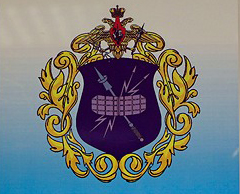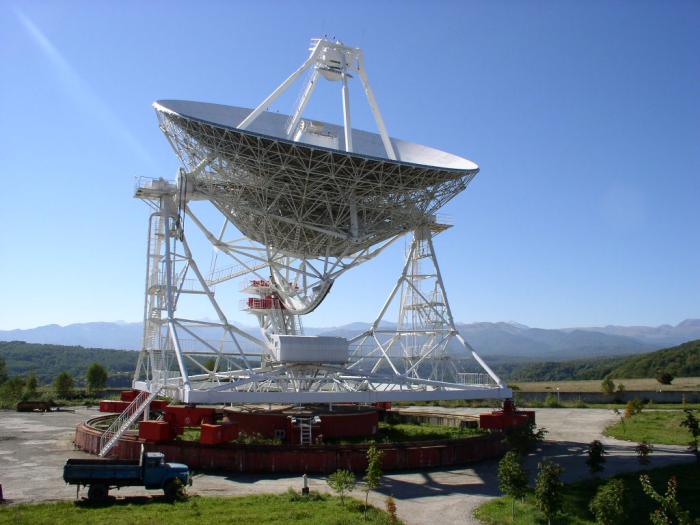|
Krona Space Object Recognition Station
Krona space object recognition station () is a Russian military complex which is used to identify objects (artificial satellites) in outer space using telescopes and radar. Space surveillance base It is part of the Centre for Outer Space Monitoring of the Russian Space Forces. The first Krona is near the village of Zelenchukskaya in Karachay-Cherkessia, North Caucasus. There is another under construction in the Russian Far East called Krona-N, near Nakhodka in Primorsky Krai. In 2007, the then commander of the Russian Space Forces Vladimir Popovkin said that the Nakhodka Krona would start in 2008, however there were no subsequent announcements. The Caucasian Krona consists of two complexes - an optical one located on Chapal mountain () above 2,000 metres and a radar installation 30 km away at a height of 1,300 metres (). One site for the Nakhodka Krona is , and this site does not have an optical component. History Krona was planned in the 1970s and onsite constructi ... [...More Info...] [...Related Items...] OR: [Wikipedia] [Google] [Baidu] |
Russian Aerospace Forces
The Russian Aerospace Forces or Russian Air and Space Forces (VKS) comprise the air force, aerial, space force, space warfare, and Missile defense, missile defence Military branch, branches of the Armed Forces of the Russian Federation. It was established on 1 August 2015 with the merging of the Russian Air Force (VVS) and the Russian Aerospace Defence Forces (VVKO), as recommended by the Ministry of Defence (Russia), Ministry of Defence to improve efficiency and logistical support. The VKS is headquartered in Moscow. Organisation Branches With the merging of the Russian Air Force and the Russian Aerospace Defense Forces, the Russian Aerospace Forces is a unified command consisting of the following branches:Russia creates new Aerospace Force service branch , jane ... [...More Info...] [...Related Items...] OR: [Wikipedia] [Google] [Baidu] |
Russian Space Forces
The Russian Space Forces () is the space force branch of the Russian Aerospace Forces. It was reestablished following the August 1, 2015 merger between the Russian Air Force and the Russian Aerospace Defence Forces, after the independent arm of service was dissolved in 2011. Formed on August 10, 1992 alongside the creation of the Russian Armed Forces, the Russian Space Forces was the first independent space force in the world. The organization shared control of the Baikonur Cosmodrome with Roscosmos, the Federal Space Agency. It also operated the Plesetsk Cosmodrome, Plesetsk and the Svobodny Cosmodromes. However the Russian Space Forces was dissolved in July 1997 and incorporated into the Strategic Missile Forces. The Russian Space Forces was once again reformed as an independent troop on June 1, 2001, under a military reorganization. However, by December 2011, it was dissolved once again and this time replaced by the Russian Aerospace Defence Forces. On August 1, 2015, the Ru ... [...More Info...] [...Related Items...] OR: [Wikipedia] [Google] [Baidu] |
Centre For Outer Space Monitoring
The 821st Main Centre for Reconnaissance of Situation in Space () is the headquarters of the Russian military's space surveillance network, SKKP. The centre is part of the Russian Space Forces and receives intelligence from a network of reporting stations which includes the Russian missile attack early warning network as well as some stations only used for space surveillance such as Okno and Krona. The purpose of the SKKP is to detect satellites, identify them and to discern their orbits. It maintains the Russian catalogue of space objects and provides data which could be used to support space launches, feed an anti-satellite programme and provide intelligence on hostile military satellites. It is the Russian equivalent of the United States Space Surveillance Network. History The centre is based in the military village of Noginsk-9 () about a kilometre to the south-west of the village of Dubrovo near Noginsk in Moscow Oblast. It was previously known as TsKKP (Цккп) from m ... [...More Info...] [...Related Items...] OR: [Wikipedia] [Google] [Baidu] |
Zelenchukskaya
Zelenchukskaya (; , , ) is a rural locality (a ''stanitsa'') and the administrative center of Zelenchuksky District of the Karachay–Cherkess Republic, Russia,Appendix to Law #84-RZ, Section I.2.3 located on the Bolshoy Zelenchuk River. Rural locality Population: In terms of population, it is the most populous rural locality in the republic. The Special Astrophysical Observatory of the Russian Academy of Science is located to the south of the stanitsa.Official website of the Special Astrophysical Observatory of the RAN.Location map History The stanitsa was founded on May 1, 1859 and named after the river on which it stands. On December 8-9, 1942, approximately 180 Jews were murdered in a mass execution perpetrated by German troops in a trench dug 2-3 km out of the village. Demographics In 2002, the population included: *Russians (77.1%) *Karachays (17.4%) *all other ethnicities comprising less than 1% of population each Climate Zelenchukskaya has a warm-summer hu ... [...More Info...] [...Related Items...] OR: [Wikipedia] [Google] [Baidu] |
Karachay-Cherkessia
Karachay-Cherkessia (), officially the Karachay-Cherkess Republic, is a republic of Russia located in the North Caucasus. It is administratively part of the North Caucasian Federal District. As of the 2021 census, Karachay-Cherkessia has a population of 469,865. Cherkessk is the largest city and the capital of the republic. Karachay-Cherkessia is one of Russia's ethnic republics, primarily representing the indigenous Caucasian-Turkic Karachay people and the Cherkess or Circassian people. Karachays form the largest ethnic group at around 44% of the population, followed by ethnic Russians (27%) and Cherkess (13%). The Cherkess are mostly of the Besleney and Kabardin tribes. The republic has five official languages: Russian, Abaza, Cherkess (Kabardian), Karachay-Balkar, and Nogai. The majority of the republic's territory is within the Caucasus Mountains, except for a small strip at the northern edge of the Don Steppe. Karachay-Cherkessia is bordered by Krasnodar Krai ... [...More Info...] [...Related Items...] OR: [Wikipedia] [Google] [Baidu] |
Russian Far East
The Russian Far East ( rus, Дальний Восток России, p=ˈdalʲnʲɪj vɐˈstok rɐˈsʲiɪ) is a region in North Asia. It is the easternmost part of Russia and the Asia, Asian continent, and is coextensive with the Far Eastern Federal District, which encompasses the area between Lake Baikal and the Pacific Ocean. The area's largest city is Khabarovsk, followed by Vladivostok. The region shares land borders with the countries of Mongolia, China, and North Korea to its south, as well as maritime boundary, maritime boundaries with Japan to its southeast, and with the United States along the Bering Strait to its northeast. Although the Russian Far East is often considered as a part of Siberia abroad, it has been historically categorized separately from Siberia in Russian regional schemes (and previously during the history of the Soviet Union, Soviet era when it was called the Soviet Far East). Terminology In Russia, the region is usually referred to as simply th ... [...More Info...] [...Related Items...] OR: [Wikipedia] [Google] [Baidu] |
Krona-N
Krona-N () is a Russian military complex which uses radar to analyse satellites and other spacecraft. It is located in Nakhodka in the Russian Far East and is part of the Centre for Outer Space Monitoring, the space surveillance section of the Russian Space Forces. Krona-N is the second Krona, the first Krona is in Zelenchukskaya in the North Caucasus. History Krona-N was mentioned in a 1980 report by Soviet military contractor Vympel on the future development of the Soviet system of space monitoring and control. This report stated that the Krona in Zelenchukskaya should be completed and proposed the development of Krona-N in the far east, and a complex called Krona-V (). Krona-V was to detect space craft in high Earth orbits, and Krona-N to detect craft in low Earth orbits. Work on Krona-N stopped in the mid 1980s but restarted sometime later. In 2005 it was described as being under construction and in late 2007 the then Space Forces commander Vladimir Popovkin was quoted as sa ... [...More Info...] [...Related Items...] OR: [Wikipedia] [Google] [Baidu] |
Nakhodka
Nakhodka ( rus, Нахо́дка, p=nɐˈxotkə, means "''finding''") is a port city in Primorsky Krai, Russia, located on the Trudny Peninsula jutting into the Nakhodka Bay of the Sea of Japan, about east of Vladivostok (169 kilometers by ca, the administrative center of the krai. Population: History The Nakhodka Bay, around which the city is organized, was first known to the Russians on the corvette '' Amerika'', which sought shelter in the bay during a storm in 1859. In honor of this occasion, the ice-free and relatively calm bay was named Nakhodka, which in Russian means "discovery" or "lucky find". An imperial settlement existed here from 1868 to 1872 but was abandoned following the death of its administrator, Harald Furuhjelm. In the fall of 1870, Otto Wilhelm Lindholm established a whaling station across the bay from the settlement. In the spring of 1871 he fitted out his schooner ''Hannah Rice'' and sailed to Posyet, where he caught six gray whales.Lindholm, O. ... [...More Info...] [...Related Items...] OR: [Wikipedia] [Google] [Baidu] |
Primorsky Krai
Primorsky Krai, informally known as Primorye, is a federal subjects of Russia, federal subject (a krais of Russia, krai) of Russia, part of the Far Eastern Federal District in the Russian Far East. The types of inhabited localities in Russia, city of Vladivostok on the southern coast of the krai is its administrative center, and the second largest city in the Russian Far East, behind Khabarovsk in the neighbouring Khabarovsk Krai. Primorsky Krai has the largest economy among the federal subjects in the Russian Far East, and a list of federal subjects of Russia by population, population of 1,845,165 as of the Russian Census (2021), 2021 Census. The krai has Russia's only North Korea–Russia border, border with North Korea, along the Tumen River in Khasansky District in the southwestern corner of the krai. Peter the Great Gulf, the largest gulf in the Sea of Japan, is on the south coast. The territory of the krai was historically part of Manchuria. It was Convention of Pek ... [...More Info...] [...Related Items...] OR: [Wikipedia] [Google] [Baidu] |
Vladimir Popovkin
Vladimir Aleksandrovich Popovkin (; 25 September 1957 – 18 June 2014) was a Russian statesman and military figure. He was a commander of the Russian Space Forces, then First Deputy Defense Minister of Russia, then General Director of the Russian Federal Space Agency. He had the military rank of General of the Army and the federal state civilian service rank of 1st class Active State Councillor of the Russian Federation. Biography Vladimir Popovkin was born on 25 September 1957 in Dushanbe, Tajik SSR, Soviet Union, where his father was serving in the 211st Tank Division. His family moved to Kalinin in 1968 where he began to study physics and mathematics. He entered service with the Soviet Army in 1975, and graduated as an engineer from Leningrad Military-Space Academy in 1979. Following graduation, Popovkin served at the Baikonur Cosmodrome in various positions, including as an engineer, head of engineering and as the launch commander of Launch Pad 1 (Gagarin's Start). After ... [...More Info...] [...Related Items...] OR: [Wikipedia] [Google] [Baidu] |
Lidar
Lidar (, also LIDAR, an acronym of "light detection and ranging" or "laser imaging, detection, and ranging") is a method for determining ranging, ranges by targeting an object or a surface with a laser and measuring the time for the reflected light to return to the receiver. Lidar may operate in a fixed direction (e.g., vertical) or it may scan multiple directions, in a special combination of 3-D scanning and laser scanning. Lidar has terrestrial, airborne, and mobile applications. It is commonly used to make high-resolution maps, with applications in surveying, geodesy, geomatics, archaeology, geography, geology, geomorphology, seismology, forestry, atmospheric physics, laser guidance, airborne laser swathe mapping (ALSM), and Mars Orbiter Laser Altimeter, laser altimetry. It is used to make digital 3D modeling, 3-D representations of areas on the Earth's surface and ocean bottom of the intertidal and near coastal zone by varying the wavelength of light. It has also been in ... [...More Info...] [...Related Items...] OR: [Wikipedia] [Google] [Baidu] |
Pamir Mountains
The Pamir Mountains are a Mountain range, range of mountains between Central Asia and South Asia. They are located at a junction with other notable mountains, namely the Tian Shan, Karakoram, Kunlun Mountains, Kunlun, Hindu Kush and the Himalayas, Himalaya mountain ranges. They are among the world's highest mountains. Much of the Pamir Mountains lie in the Gorno-Badakhshan region of Tajikistan. Spanning the border parts of four countries, to the south, they border the Hindu Kush mountains along Afghanistan's Wakhan Corridor in Badakhshan Province, Chitral District, Chitral and Gilgit-Baltistan regions of Pakistan. To the north, they join the Tian Shan mountains along the Alay Valley of Kyrgyzstan. To the east, they extend to the range that includes China's Kongur Tagh, in the "Eastern Pamirs", separated by the Yarkand River, Yarkand valley from the Kunlun Mountains. Since the Victorian era, they have been known as the "Roof of the World", presumably a translation from Persian ... [...More Info...] [...Related Items...] OR: [Wikipedia] [Google] [Baidu] |





